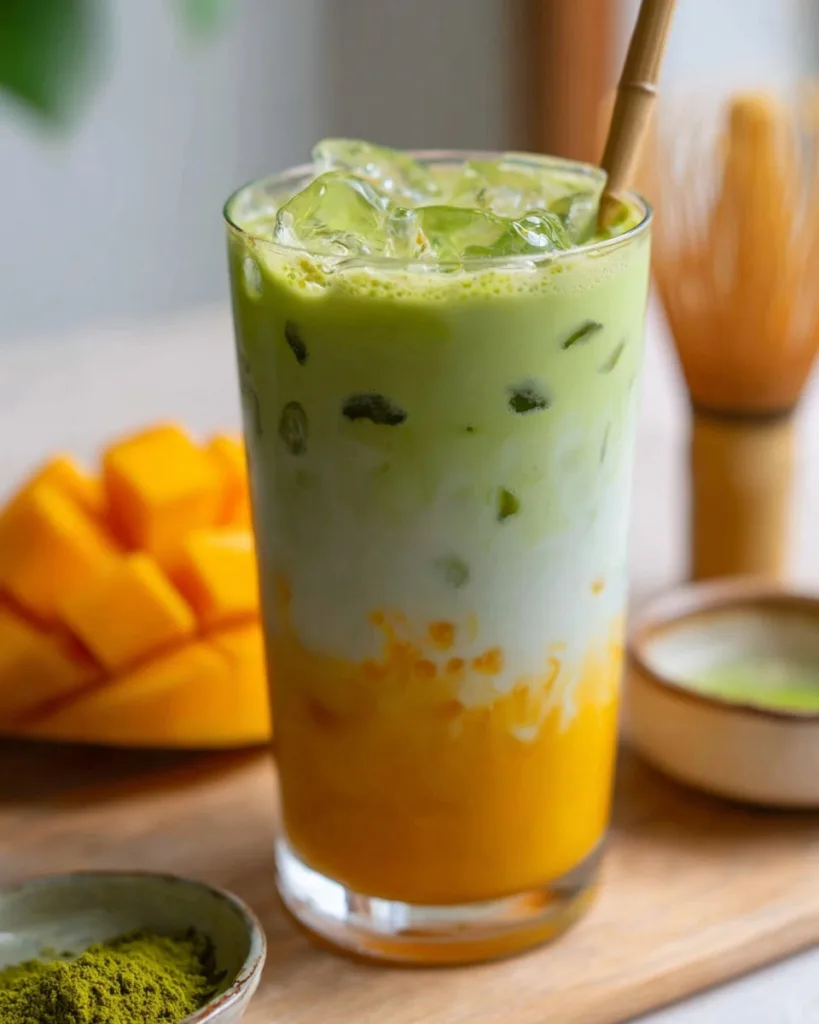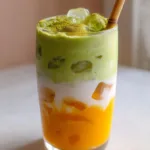Oh my gosh, you have to try this Mango Matcha Latte it’s like sunshine in a glass! I stumbled upon this magical combo last summer when I had way too many ripe mangoes and a serious matcha addiction. The sweet, tropical mango puree balances matcha’s earthy notes perfectly, creating this vibrant drink that’s both refreshing and energizing.

Table of Contents
What I love most (besides that gorgeous green-and-orange swirl) is how ridiculously easy it is to make. No fancy equipment needed blender for blender for the mango and a whisk for the matcha. It’s become my go-to afternoon pick-me-up when I need something cooler than hot tea but more exciting than plain iced coffee. Trust me, once you taste that creamy mango-meets-matcha goodness, you’ll be hooked!
This drink pairs well with a fruity strawberry matcha boba
Why You’ll Love This Mango Matcha Latte
This isn’t just another matcha drink it’s a total game-changer! Here’s why it’ll become your new obsession:
- Refreshing twist: The tropical mango cuts through matcha’s earthiness for the perfect balance of sweet and savory
- Effortless to make: Ready in under 10 minutes with just a blender and whisk
- Naturally sweet: Ripe mango means you can skip extra sugar (but honey drizzle never hurts!)
- Instagram-worthy: Those gorgeous orange-and-green layers make every sip feel special
- Customizable: Dairy-free? Swap the milk! Want more kick? Double the matcha!
Seriously, it’s summer in a glass year-round. Enjoy alongside chewy matcha mochi cookies.
Ingredients for Mango Matcha Latte
You’ll be shocked how just a few simple ingredients create something so magical! Here’s what you need to grab:
- 1 ripe mango (peeled, pitted, and diced trust me, fresh beats canned!)
- 1 teaspoon matcha green tea powder (sifted no clumps allowed!)
- 2 oz hot water (about 175°F boiling water makes matcha bitter)
- 1 teaspoon honey, agave, or maple syrup (or more to taste)
- 6 oz milk of choice (I’m obsessed with oat milk here)
- Handful of ice cubes (the bigger, the slower they melt!)
That’s it! Now let’s make some magic happen.

How to Make Mango Matcha Latte
Okay, let’s get mixing! This drink comes together in three easy parts just follow these steps and you’ll be sipping paradise in no time.
Making the Mango Puree
Toss those juicy mango chunks into your blender and whiz until completely smooth no lumps allowed! You want a thick, velvety puree that’ll sit pretty at the bottom of your glass. Set this sunshine in a bowl aside while we work on the matcha.
Preparing the Matcha
Here’s where the magic happens! Sift your matcha powder into a small bowl (this prevents those pesky clumps). Pour in the hot water not boiling, or you’ll get bitter matcha and whisk vigorously in a zigzag motion for about 15-20 seconds until frothy. Stir in your sweetener of choice. Pro tip: If you don’t have a bamboo whisk, a small milk frother works wonders!
Assembling the Drink
Time for the fun part! Spoon that gorgeous mango puree into your glass about ¼ full. Add a generous handful of ice, then slowly pour in your milk, leaving about an inch at the top. Now gently pour the matcha over the back of a spoon to create those Instagram-worthy layers. The colors should stay separate at first, then swirl beautifully when you stir!
Tips for the Perfect Mango Matcha Latte
Want to take your mango matcha latte from good to “oh wow!”? Here are my foolproof tricks:
- Pick the ripest mango you can find it should smell sweet and give slightly when squeezed (no sour surprises!)
- Taste as you go add more honey if your mango isn’t super sweet, or an extra pinch of matcha if you want more earthy kick
- Froth your milk first for extra creaminess just 15 seconds with a frother makes all the difference
- Use room temp mango cold fruit can make the drink watery when blended
- Go slow with the matcha pour that gorgeous layered effect needs patience!
Now go make some magic!

Mango Matcha Latte Variations
Don’t be afraid to play around with this recipe I’ve tried dozens of versions! Swap oat milk for coconut milk to make it tropical paradise in a glass. A pinch of cinnamon or cardamom adds warmth, while frozen mango works great when fresh isn’t available. Sometimes I’ll even blend in a teaspoon of turmeric for a golden matcha latte that’s as pretty as it is healthy!
Serving and Storing Mango Matcha Latte
Drink this beauty immediately those dreamy layers start mixing the second you walk away! The mango puree and matcha will settle if stored, so I always make it fresh. If you must prep ahead, keep the puree and matcha separate in the fridge (up to 24 hours), then assemble when ready.
Mango Matcha Latte Nutritional Information
Here’s the scoop on what’s in your glass each serving packs about 180 calories with 24g of natural sugars from the mango and honey. You’ll get 6g of protein (thanks, milk and matcha!) and 3g of fiber. Of course, these numbers shift if you use different milks or adjust the sweetener. My oat milk version tends to be slightly higher in carbs but lower in fat than dairy. Either way, it’s a delicious way to get antioxidants from matcha plus a vitamin C boost from fresh mango!

Frequently Asked Questions
Does matcha go well with mango?
Yes, matcha and mango can be a delicious pairing! The earthy, slightly bitter, and umami notes of matcha can complement the sweet and tropical flavor of mango. This combination works well in drinks like smoothies and lattes, creating a refreshing and balanced taste. Some even describe the pairing as a “perfect balance of flavors” where the mango’s sweetness smooths out matcha’s slight bitterness.
Are matcha lattes good or bad for you?
Matcha lattes can be a healthy addition to your diet, but it depends on how they are prepared and consumed.
– Potential Benefits:
Rich in Antioxidants: Matcha is packed with catechins, a type of antioxidant that helps protect against cell damage.
Calm Alertness: Matcha contains L-theanine, an amino acid that can promote relaxation and focus, often providing sustained energy without the “jitters” some experience with coffee.
May Support Heart Health: Some research suggests green tea compounds, also found in matcha, may contribute to cardiovascular wellness by helping manage cholesterol and blood sugar levels.
Potential Metabolism Boost: Some studies indicate that compounds in matcha might modestly support weight management by boosting metabolism, especially when combined with exercise.
– Potential Drawbacks:
Added Sugars and Calories: Many commercially prepared or homemade matcha lattes contain significant amounts of sugar and high-fat milk, which can add extra calories and negate some health benefits if consumed in excess.
Caffeine Content: Matcha contains caffeine, which can cause side effects like insomnia or an increased heart rate in sensitive individuals or if consumed in large quantities.
Contaminants: Like other tea plants, matcha can potentially absorb contaminants from the soil.
Impact of Dairy: Some sources suggest that casein, a protein in dairy milk, might bind to the beneficial polyphenols in matcha, potentially reducing their absorption by the body. Opting for plant-based milk may be preferable if this is a concern.
In moderation, especially when made with minimal sugar and high-quality ingredients, matcha lattes can be a beneficial beverage.
How to make an iced mango matcha latte?
Making an iced mango matcha latte at home is quite simple. Here’s a general guide:
Prepare the Mango Puree: Blend fresh or thawed frozen mango chunks until smooth. You can add a little water if needed to help it blend. Some recipes suggest adding a squeeze of lime or a touch of sweetener like honey or maple syrup to the puree.
Whisk the Matcha: Sift matcha powder (ceremonial grade is often recommended for best flavor) into a small bowl. Add a small amount of hot (not boiling, around 80°C/176°F is ideal) water. Whisk vigorously, often in a “W” or “M” motion, until frothy and no clumps remain. You can add your preferred sweetener to the matcha at this stage if desired.
Assemble the Drink:
Add the mango puree to the bottom of your glass.
Fill the glass with ice.
Pour in your milk of choice (oat, almond, coconut, or dairy all work, each offering a slightly different texture and flavor).
Gently pour the prepared matcha over the milk to create distinct layers.
Stir and Enjoy: Stir the layers together before drinking to combine the flavors.
You can adjust the amounts of mango, matcha, milk, and sweetener to your preference.
What can you not mix with matcha?
While matcha is versatile, some flavors and ingredients might not pair as well or could potentially diminish its qualities:
Overly Bitter or Tannic Ingredients: Since matcha itself has some natural astringency, pairing it with ingredients that are also very bitter or tannic (like heavy amaro or very dark chocolate in large amounts) can sometimes clash.
Excessive Acidity: While a little citrus (like lemon or yuzu) can brighten matcha’s earthiness, too much acidity can overwhelm its more subtle notes. Some find that strong citrus flavors can enhance the astringent components of matcha in a way that isn’t always desirable.
Very Rich, Overpowering Flavors: Matcha has a distinct and somewhat delicate flavor. If paired with extremely strong or rich foods (like heavy, rich chocolate cakes or intensely flavored fruit pies), the matcha flavor can get lost or create a confusing taste experience. The goal is usually to complement or subtly contrast matcha’s notes, not overpower them.
Dairy Milk (Potentially for Health Benefits): As mentioned earlier, some sources indicate that the casein protein in dairy milk might interfere with the absorption of matcha’s antioxidants. If maximizing health benefits is a priority, you might choose to avoid dairy milk or opt for plant-based alternatives.
Boiling Water: Using water that is too hot (boiling) when preparing matcha can scorch the powder, resulting in a bitter taste. An ideal temperature is around 80°C (176°F).
Ultimately, taste is subjective, but these are general guidelines for pairings that might not be optimal.
What’s the best type of mango to use?
Go for super ripe Ataulfo or Honey mangoes they’re naturally sweeter and blend smoother than the larger Tommy Atkins variety. If your mango isn’t super soft, let it ripen on the counter for a day or two. Trust me, that extra wait makes all the difference in flavor!
Can I substitute the matcha powder?
While nothing quite replaces matcha’s unique taste, you could try green tea powder in a pinch (just use half the amount). For caffeine-free options, moringa powder gives a similar earthy vibe, though the color will be different. But honestly? Splurge on good matcha it’s worth it!
What milk alternatives work best?
My top picks are oat milk (creamy texture) or coconut milk (tropical twist). Almond milk works too, but it’s thinner try the barista blend versions for better froth.
Pro tip: Shake your plant milk before pouring to avoid separation!

Mango Matcha Latte Recipe
- Total Time: 10 minutes
- Yield: 1 serving 1x
- Diet: Vegetarian
Description
Enjoy a vibrant and refreshing twist on your classic matcha latte. This Mango Matcha Latte combines creamy milk, earthy matcha, and sweet mango puree perfect for warm days or a fruity afternoon pick-me-up.
Ingredients
- 1 ripe mango (peeled and diced)
- 1 teaspoon matcha green tea powder
- 2 oz hot water (not boiling)
- 1 teaspoon liquid sweetener (honey, agave, or maple syrup)
- 6 oz milk (dairy or plant-based)
- Ice cubes
Instructions
- Make the Mango Puree: Add mango pieces to a blender or food processor. Blend until smooth. Set aside.
- Prepare the Matcha: Sift matcha powder into a small bowl to remove clumps. Add 2 oz of hot (not boiling) water. Whisk using a bamboo whisk or milk frother for 15–20 seconds until frothy. Stir in the sweetener.
- Assemble the Drink: Add mango puree to the bottom of a glass (about 1/4 full). Fill the glass with ice. Pour in the milk, leaving room for the matcha. Slowly pour the matcha over the top for a layered effect.
- Serve and Enjoy: Stir gently before drinking. Enjoy immediately as a refreshing iced beverage.
Notes
- Use ripe mangoes for natural sweetness.
- For extra creaminess, use whole milk or oat milk.
- Adjust sweetness to taste.
- Prep Time: 5 minutes
- Cook Time: 5 minutes
- Category: Beverage
- Method: Blending, Whisking
- Cuisine: Fusion
Nutrition
- Serving Size: 1 glass
- Calories: 180
- Sugar: 24g
- Sodium: 50mg
- Fat: 4g
- Saturated Fat: 2g
- Unsaturated Fat: 1g
- Trans Fat: 0g
- Carbohydrates: 32g
- Fiber: 3g
- Protein: 6g
- Cholesterol: 10mg
Keywords: Mango Matcha Latte, Matcha Drink, Iced Matcha, Refreshing Beverage




